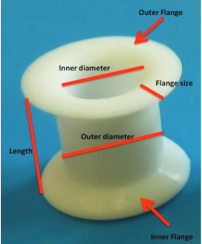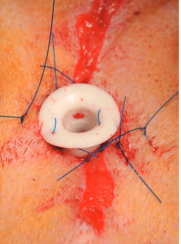Dr Kat Crosse is looking forward to the VetPrac Fix the Face workshop in October 2-4, 2020, where she will have an opportunity to discuss with workshop participants the pros and cons of using a cool tracheostomy device that is set to replace tracheostomy tubes, and may revolutionise tracheostomies with better outcomes for our patients. Kat is a Senior Lecturer in Companion Animal Surgery at Massey University, New Zealand, and in her spare time is doing a PhD working towards understanding the welfare, anatomical and physiological challenges faced by brachycephalic breeds.

Silicone tracheal stoma stent (flesh tunnel). Annotated picture of 10-mm silicone tracheal stoma stent. Length, inner flange, outer flange, flange size, inner diameter and outer diameter are marked.
Photo courtesy of Journal of Small Animal Practice 2014; 55: 551–559.
Temporary airway diversion by means of a tracheostomy is commonly employed as a means of alleviating severe episodes of upper airway obstruction. A study by Nicholson and Baines published in 20121 reported a complication rate of 86% in dogs undergoing temporary tracheostomy and unsuccessful tracheostomy tube management resulted in death in 19% of the dogs included in that study. The potential for displacement of the tube and obstruction with tracheal secretions means that successful outcome relies on intensive management to provide regular nebulisation, flushing, suctioning and cleaning (Nicholson & Baines 20102).
Postoperative complications reported to occur with conventional tracheostomy tubes include obstruction, dislodgement, swelling of the stoma site, gagging, coughing, vomiting, subcutaneous emphysema, pneumomediastinum, respiratory distress, aspiration pneumonia, pneumothorax, haemorrhage and sinus bradycardia (Harvey & O’Brien 19823, Hedlund et al, 19884).
Silicone tracheal stoma stents (flesh tunnels) provide a novel approach to the management of temporary tracheostomy in dogs with upper airway obstruction, and may in selected cases provide a suitable alternative to conventional tracheostomy tubes. The tracheal stoma stent appears to be relatively easy to insert and may result in a more stable fit within the trachea than conventional tracheostomy tubes. The point of difference for these stents is that they do not occupy the tracheal lumen. They provide instead, improved visualisation of the trachea via the short, straight lumen of the stent, which may facilitate easy cleaning and removal of mucoid plugs.

Tracheal stoma stent sutured in place. The tracheal stoma stent has been sutured to the skin with horizontal mattress sutures. Photo courtesy of Journal of Small Animal Practice 2014; 55: 551–559.
Flesh tunnels are silicone stents used to maintain the patency of body piercings and have long been used as a form of jewellery in humans; they are designed as hollow tubes with flanges at each end. Flesh tunnels are comparatively inexpensive and are readily available from body jewellery suppliers in sizes ranging from 4 to 50 mm in diameter.
Longer-term use (>5 days) of flesh tunnels cannot be recommended because of granulation tissue formation, and conversion to a permanent tracheostomy is advised if a dog is tracheostomy dependent beyond this time.
If you’re keen to learn more about this novel approach before VetPrac’s Fix the Face Workshop in October, Kat has provided a great journal article which describes a group of 18 dogs that were managed with these silicone tracheal stoma stents.
In the meantime, Kat suggests always rereading this article before you attempt it! She also recommends having a lot of sizes and finding soft obturators as they need to be squashed/ folded to get them in.
Kat can be contacted at [email protected]
______________________________________________________________________
- Nicholson, I. & Baines, S. Complications associated with temporary tracheostomy tubes in 42 dogs (1998 to 2007). Journal of Small Animal Practice 2012; 53: 108-114
- Nicholson, I. & Baines, S. J. Indications, placement and management of tracheostomy tubes. In Practice 2010; 32: 104.
- Harvey, C. E. & O’Brien, J. A. Tracheotomy in the dog and cat: analysis of 89 episodes in 79 animals. Journal of the American Animal Hospital Association 1982; 18: 563-566
- Hedlund, C. S. et al. Permanent tracheostomy: perioperative and long-term data from 34 cases. Journal of the American Animal Hospital Association 1988; 24: 585-591
